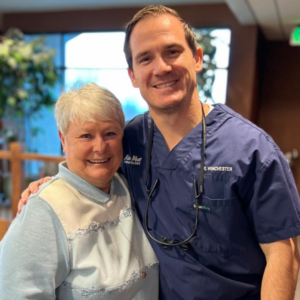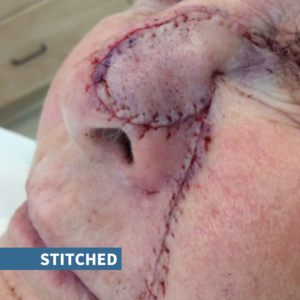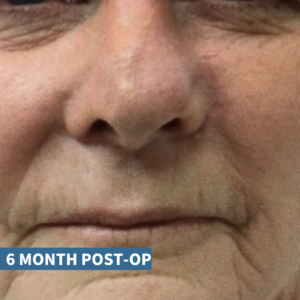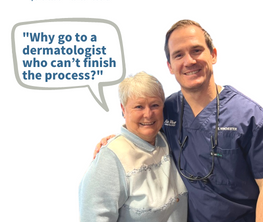
Our patient, Jan, started seeing a dermatologist almost 40 years ago– for skin cancer. Because her genetic predisposition, fair skin, and childhood sunburns by the lake compounded her likelihood of skin cancer, she has had her fair share of subsequent surgeries– including one for a stage 2 cancer on her temple. And she’s had skin cancer at other offices partially removed/cauterized with poor results.
Only recently did her skin cancer removal come with the benefits of a Mohs fellowship-trained physician. She explains why she now prefers to drive 45 miles to Ada West Dermatology from her small southwest Idaho town every 6 months.
Not only is the on-site lab practical, but very much what gives Mohs technique the highest cure rate. As Jan will tell you, Dr. Winchester‘s patience and pace matters, too. As Jan explains, “I know he’s so busy with his schedule. I get that, but when you walk in here you are the only person he cares about and that just makes him a good doctor. He doesn’t make you feel like you need to rush out of here. And he will wait ’til you’re through visiting or looking or asking questions. He just makes you feel very comfortable. ”
Jan has also been really happy with the results of Mohs micrographic surgery. It can be scary for anyone who needs surgery on their face, but Jan says that she’s really the only one who notices her scar and that “Dr. Winchester works miracles.”
If a patient’s type and location of cancer qualifies for Mohs surgery the out-patient process is simple. First the doctor examines the spot and biopsy and the cancer layer is removed. Then it is analyzed by the Mohs lab and examined by the surgeon himself. If any remaining skin cancer remains, another layer is removed at the precise location needed. Then, while you wait, the lab work begins again. This entire process is repeated as many times as needed until there are no more cancer cells. Once the site is clear of all cancer cells, the wound may be left open to heal or the surgeon may close it with stitches. Depending on how deep or wide the cancer has grown it can take a few hours or all day.
“I just think, why go to a dermatologist who can’t finish the process?”
–Jan, Mohs surgery patient
Ada West Dermatology is proud to have two fellowship trained Mohs surgeons on staff who care deeply about the best possible outcome for their patients. They take into consideration how the face will function and how patients can look their very best when fully healed.
Like many patients of Jan’s generation, the use of sunscreen all day and year round has become her new habit. She isn’t shy to share (gently) the need for SPF as she would say: “Your children need to put on sunscreen just like they put on their socks and shoes.”
These are some photos of her progression through the surgery and post-surgery healing.














